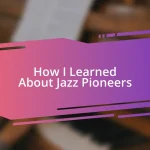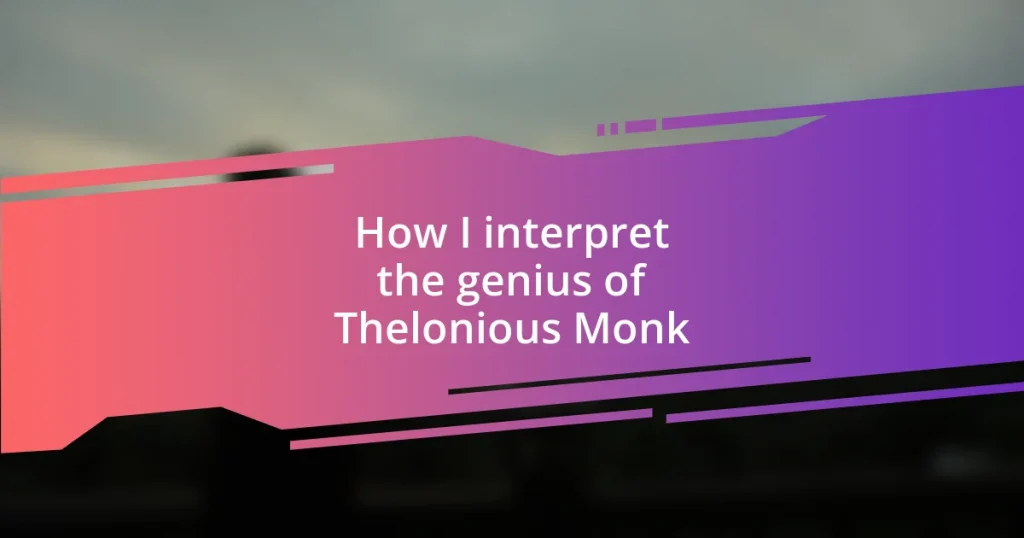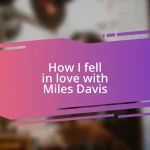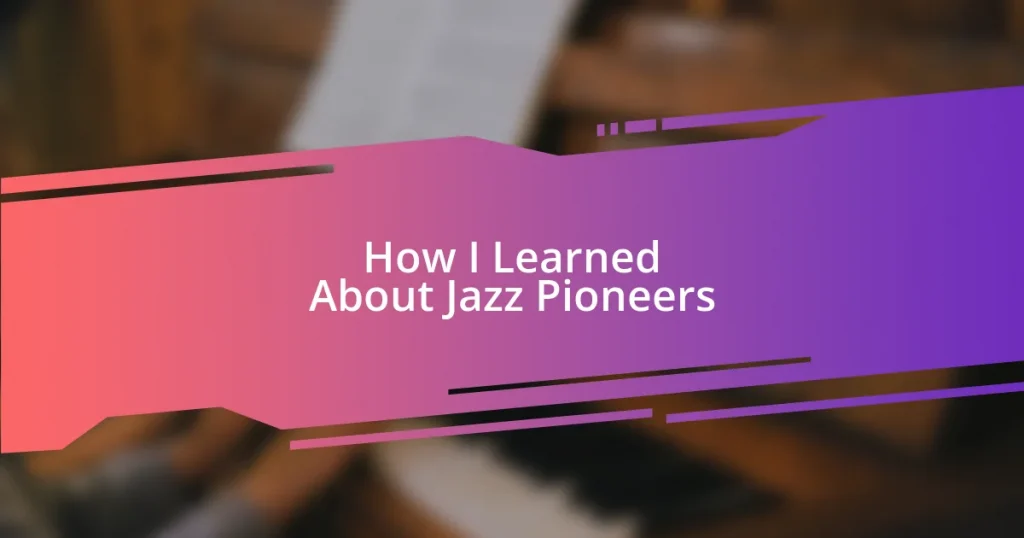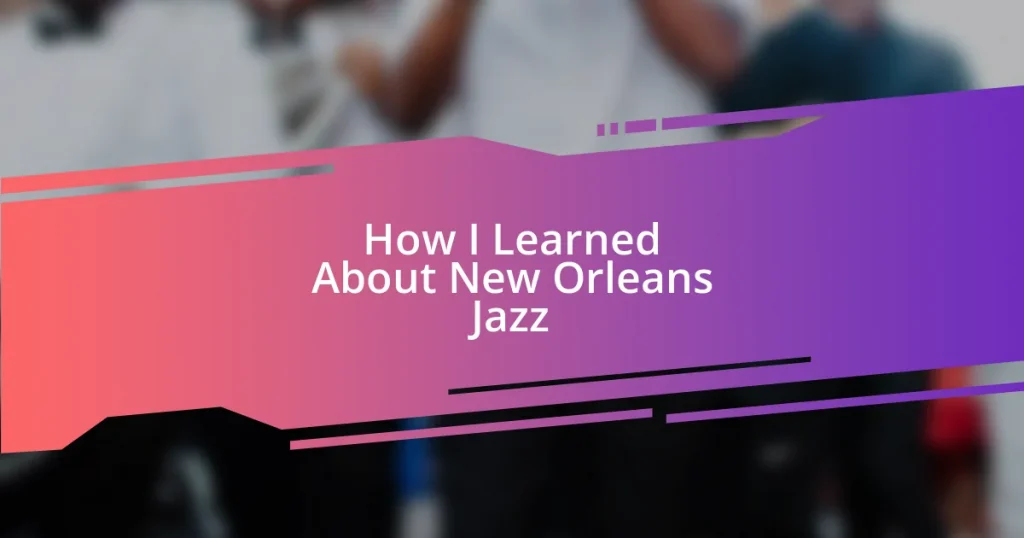Key takeaways:
- Thelonious Monk’s unique style blends dissonance, rhythm, and improvisation, inviting listeners to explore new sonic landscapes and emotional depths.
- His compositions, such as “Straight, No Chaser,” “Well, You Needn’t,” and “Ruby, My Dear,” demonstrate the intricate balance of simplicity and complexity, often evoking strong emotions and engaging listeners in a musical conversation.
- Monk’s influence on jazz emphasizes authenticity, risk-taking, and rhythmic freedom, inspiring musicians to embrace individuality and explore unexpected creative directions in their music.
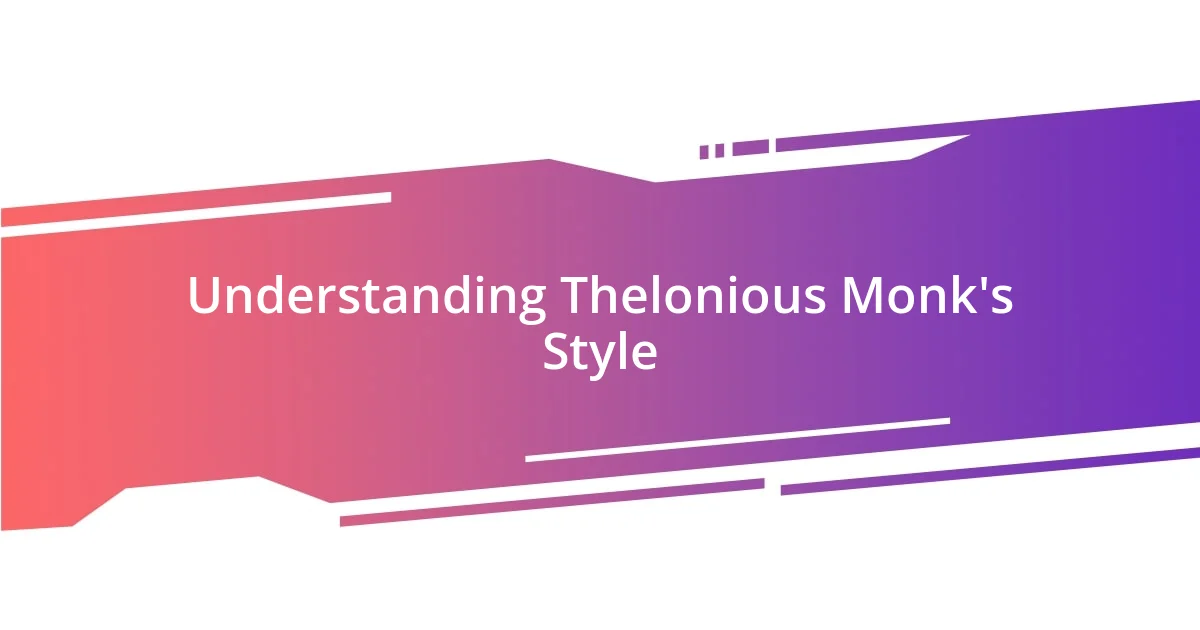
Understanding Thelonious Monk’s Style
Thelonious Monk’s style is an intriguing blend of dissonance and rhythm that challenges conventions. His use of self-taught techniques, which often led him to create unexpected chords, makes his music feel like a puzzle waiting to be solved. I remember the first time I heard “Round Midnight”; I found myself captivated by the way he danced around melody, creating tension that was almost palpable.
What strikes me about Monk is his fearless approach to improvisation. He breaks the rules with such confidence that it feels liberating, as if he’s inviting us to step outside of traditional boundaries and explore new sonic landscapes. His deliberate pauses and syncopated rhythms not only showcase his technical prowess but also communicate a depth of emotion. Have you ever felt the weight of silence in music? In Monk’s work, even a momentary pause can convey longing or introspection.
In his compositions, there’s a playful, almost childlike spirit alongside a profound sophistication. Each note feels intentional, like he’s weaving a story of his own life experiences. When listening to “Blue Monk,” I often reflect on how Monk masterfully blends simplicity with complexity—how can something so straightforward evoke such deep feelings? It’s a testament to his genius, reminding us that there’s often more beneath the surface than meets the eye.
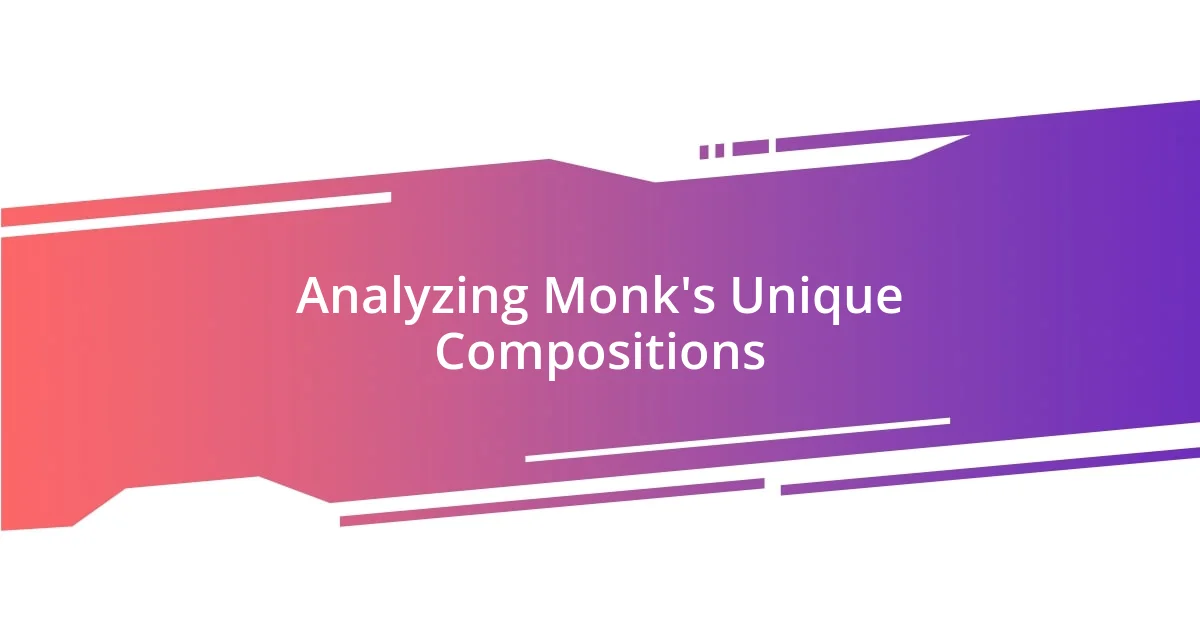
Analyzing Monk’s Unique Compositions
Monk’s unique compositions often challenge my understanding of musical structure. Take “Straight, No Chaser,” for example; it’s a piece that seems simple at first glance, yet each repetition reveals new intricacies. The way he navigates through the harmonic progressions feels like watching a master magician at work—every twist draws me further into his world while leaving me in awe.
When I listen to “Well, You Needn’t,” I’m struck by how Monk transforms a straightforward melody into a conversation. His playful interactions with the rhythm remind me of a dance, inviting the listener to engage actively. I recall sitting with friends as we analyzed this piece together, discovering how even the smallest accents in his playing can shift the entire feel of the music. It’s these nuances that create delightful surprises, making each listen a fresh experience.
Moreover, the contrasts in Monk’s works mirror the complexities of human emotion. In “Ruby, My Dear,” there’s a haunting melancholy that resonates with me deeply. I once shared this track with someone going through a tough time, and we both found solace in its wistfulness. It’s fascinating how Monk’s compositions can evoke such powerful feelings, turning mere notes into a compelling narrative that stays with us long after the music fades away.
| Composition | Key Features |
|---|---|
| “Straight, No Chaser” | Simple yet intricate harmonic progressions; a masterclass in repetition. |
| “Well, You Needn’t” | Playful rhythm; feels like a musical conversation with unexpected twists. |
| “Ruby, My Dear” | Haunting melancholy; evokes deep emotional resonance and reflection. |
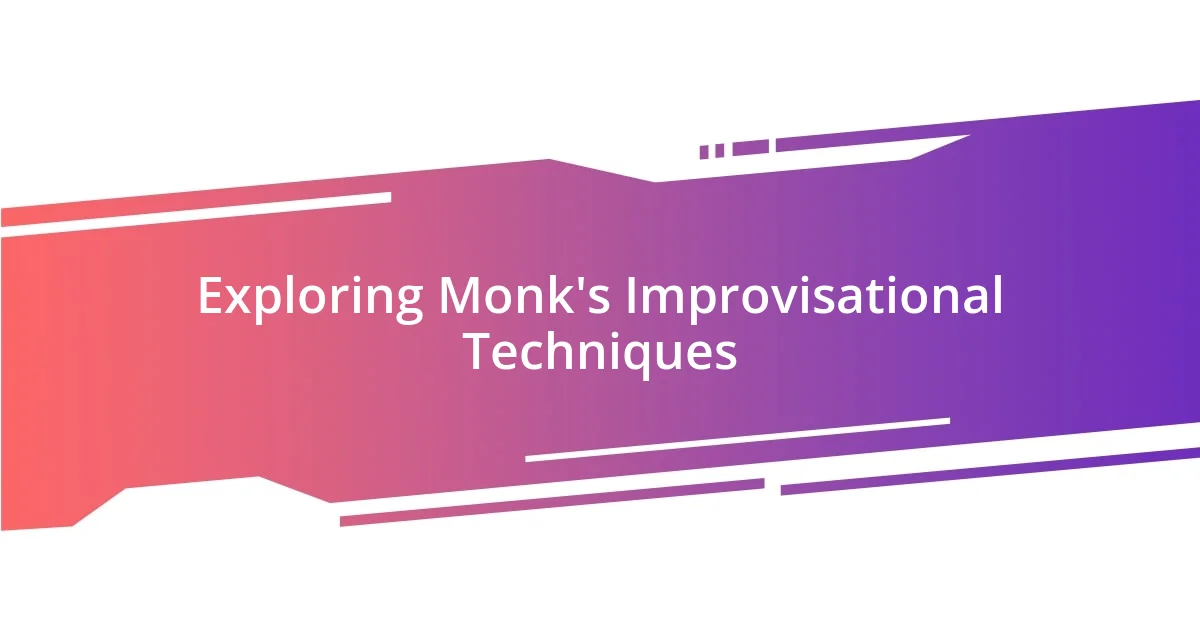
Exploring Monk’s Improvisational Techniques
Monk’s improvisational techniques always leave me in awe. The way he blends unexpected notes and rhythms feels almost spontaneous, like he’s having an intimate chat with his piano. I recall a moment during a jam session when someone asked me to emulate Monk’s style. It was challenging! His ability to create complex textures with seemingly simple ideas taught me that jazz improvisation isn’t just about hitting the right notes; it’s about expressing an emotion at that very moment.
Here are some of the key elements of Monk’s improvisational techniques:
- Dissonance and Resolution: Monk often employed dissonant intervals that would resolve in ways that surprised and delighted listeners.
- Rhythmic Playfulness: His improvisations are filled with syncopation, creating an infectious groove that challenges the listener to find the underlying beat.
- Deliberate Pauses: Monk’s use of silence speaks volumes, pausing for effect and allowing emotional weight to build before leaping back into the melody.
- Motivic Development: I’ve noticed how he takes a simple melodic idea, then transforms and develops it throughout the piece, creating a dialogue within his music.
- Unique Phrase Lengths: Unlike conventional jazz phrases, Monk often varied the lengths, creating an unpredictability that kept me on my toes.
In essence, these improvisational techniques forge a powerful connection. I’ve found that each time I explore Monk’s improvisations, I discover something new, much like revisiting a cherished book. His unique approach reminds us that music is a living expression—rich with nuance and emotion.
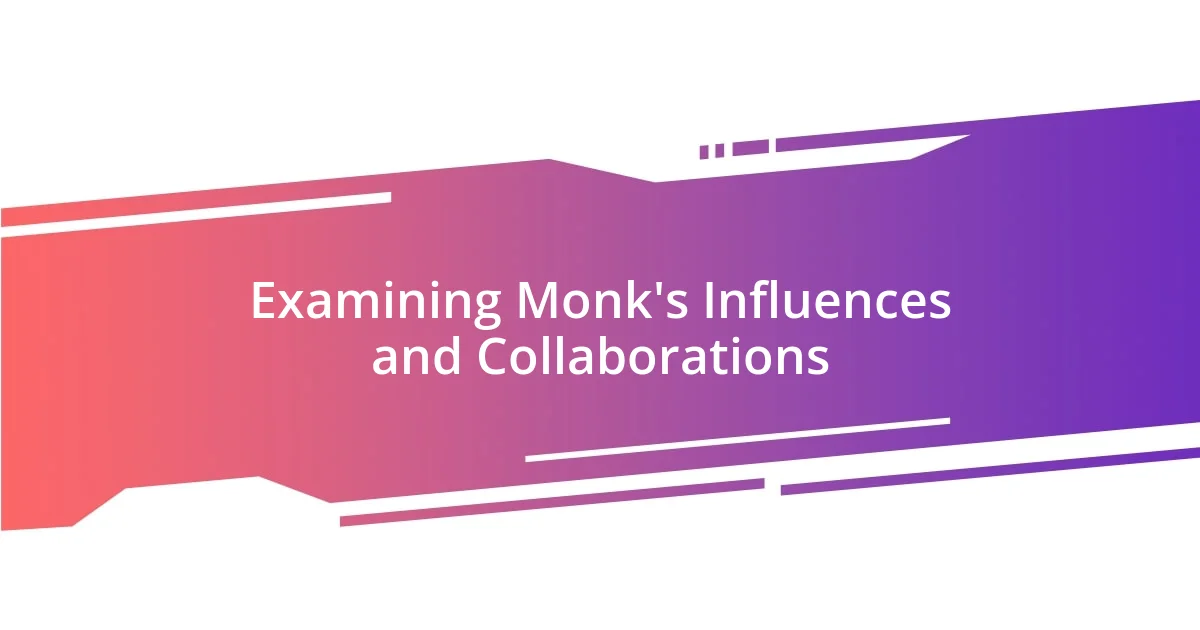
Examining Monk’s Influences and Collaborations
Collaborating with other musicians played a significant role in shaping Monk’s distinctive sound. I remember the first time I heard his work with artists like John Coltrane; it was as if two forces of nature were having an electrifying conversation. Those sessions not only showcased Monk’s innovative piano stylings but also highlighted how collaboration can amplify a musician’s voice, creating rich, layered textures that resonate deeply with listeners.
Monk had a natural chemistry with his peers, like during his time with legendary bassist Charles Mingus. I love how their musical chemistry sparked creativity. One listening session had me reflecting on how their improvisational duets felt so alive—like watching two dancers in perfect synchrony, each one challenging and uplifting the other. It’s a reminder that collaboration often leads to breakthroughs that an individual might struggle to achieve alone.
His influence also extended to younger musicians, paving the way for generations ahead. When I see contemporary jazz artists reference Monk, I feel a sense of awe. It’s powerful to think of how his unique voice continues to inspire and challenge new talent to break boundaries, keeping the essence of his genius alive. Isn’t it fascinating how one artist can have such a wide-reaching impact, like ripples in a pond that continue to spread outwards? Monk’s collaborations exemplify that beautiful chain of musical evolution.
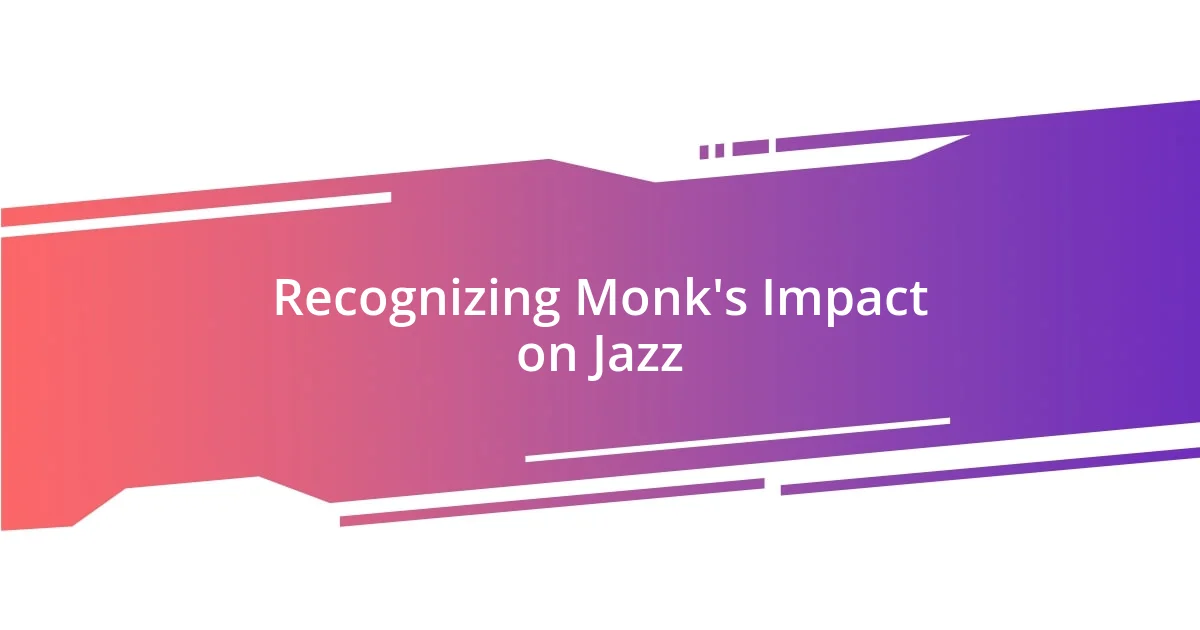
Recognizing Monk’s Impact on Jazz
Recognizing Thelonious Monk’s impact on jazz is more than just acknowledging his unique sound; it’s about understanding how he reshaped the framework of the genre. I still remember the first time I truly listened to “Round Midnight.” It was as if I stumbled upon a hidden world where every note resonated with complexity and depth. Monk’s groundbreaking contributions, particularly his use of dissonance, forced me to reconsider what jazz could be, inviting me into an unexpected musical journey.
It’s incredible how Monk’s style has infused a sense of freedom into jazz. For instance, I once attended a local jazz performance, and the pianist openly referenced Monk’s influence in his improvisation. Watching him dive into unconventional turns and playful rhythms, I realized the weight of Monk’s legacy—his avant-garde approach encourages younger musicians to embrace their individuality. With each note, there’s an implicit challenge to break free from tradition while still honoring its roots. Can you feel the exhilaration of that freedom when you listen to his music?
Moreover, Monk’s rhythms often convey a joyful spontaneity that sparks inspiration. Just last week, while jamming with friends, we decided to dive into a Monk piece without fully preparing. That spontaneity mirrored his improvisational spirit, leading us to create something new and unexpected, just as he did. I firmly believe that recognizing Monk’s impact means celebrating how he invites us to explore unexplored territories in our musical and emotional landscapes. His genius not only redefined jazz but also opened doors to endless possibilities in creative expression.
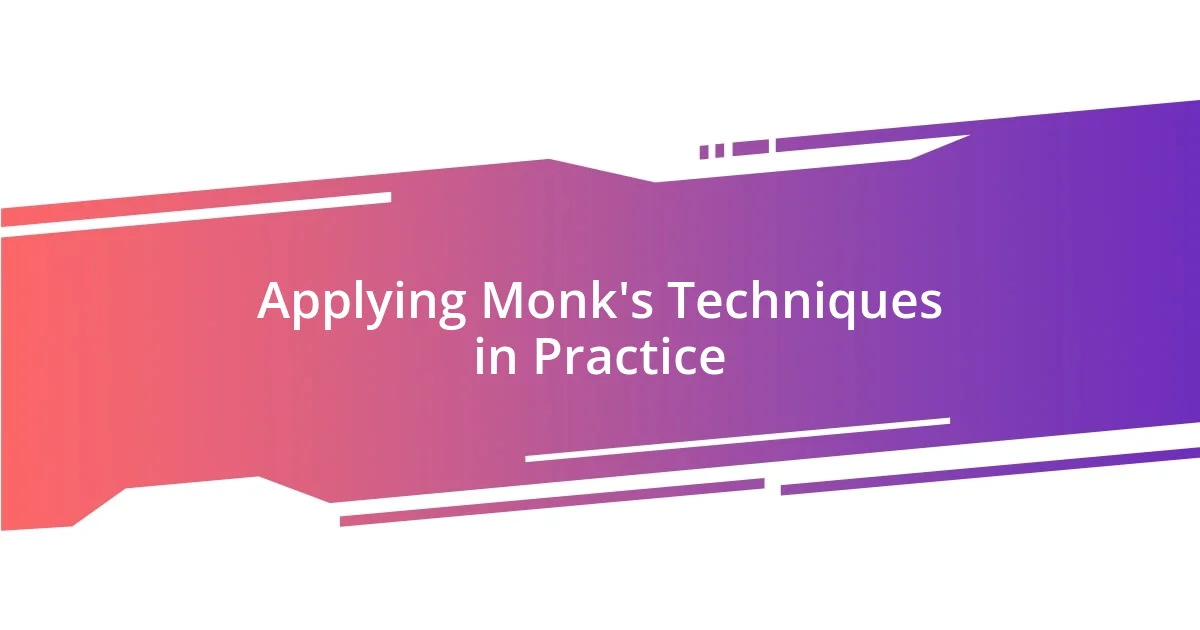
Applying Monk’s Techniques in Practice
Applying Monk’s techniques in practice reveals a world of creative possibilities. One day, while experimenting with a piece I loved, I stumbled upon Monk’s signature use of silence—moments where the music just breathes. Suddenly, I was reminded of a time I attended a live Monk tribute, where the pianist paused dramatically before hitting the next note. That silence created a palpable tension in the room; it made me feel as if the whole audience was holding its breath, waiting for magic to happen.
I often find myself infusing Monk’s playful yet complex angular melodies into my own compositions. There’s something thrilling about exploring unexpected intervals—like when I hesitated, then leaped into a dissonant chord while jamming with a friend. It sparked a lively debate on where we could take the piece next, showing me how Monk’s daring approach encourages experimentation and conversation within the music. I’ve realized that applying his techniques is not just about mimicking his style but embracing similar boldness that invites creativity.
The rhythmic interplay in Monk’s work fascinates me. I remember a practice session where I played with syncopation, channeling Monk’s essence. It was invigorating! The off-beat accents felt like I was dancing with the music instead of just playing it. I can’t help but wonder: how many musicians overlook the joy of exploring these unconventional rhythms? Monk’s genius teaches us that there’s so much power in rhythmic freedom, inviting us to let go of strict patterns and revel in the spontaneity of our own musical journeys.
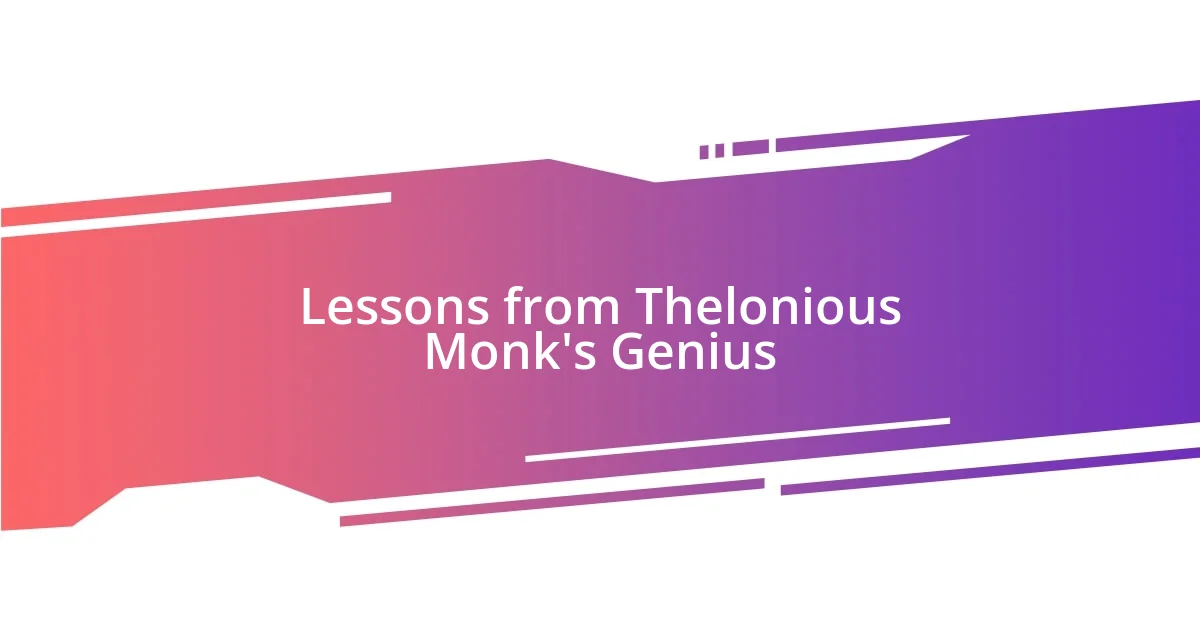
Lessons from Thelonious Monk’s Genius
The genius of Thelonious Monk teaches us the power of authenticity in music. I vividly recall a time when I was struggling to find my voice in a crowded jam session. I took a deep breath and let my fingers wander, channeling Monk’s fearless approach to improvisation. Suddenly, I played a wonky chord that felt utterly unrefined, yet it felt so genuine. It liberated me in that moment, reminding me that embracing our true selves often leads to the most profound musical expressions.
Embracing dissonance is another invaluable lesson from Monk. I remember trying to incorporate dissonant chords into a familiar tune during a small performance. My heart raced as I ventured off the beaten path. At first, the audience seemed startled, their faces a mix of confusion and curiosity. However, as the tension resolved into a softer harmony, I saw smiles spread across their faces. It clicked for me: taking risks can create connections that transcend mere notes on a page, illuminating the beauty in uncertainty.
Monk’s influence on rhythm constantly inspires me to redefine structure in my playing. I once experimented with an upbeat melody, introducing a sudden and unexpected lull in the tempo. That created a unique groove that caught my bandmates off guard. The energy in the room shifted, and we all thrilled at finding a new rhythm together. It sparked an exciting dialogue that reshaped our performance that night. Isn’t it fascinating how a little deviation from the norm can turn a simple tune into a shared adventure? Monk’s genius lies in his ability to encourage us all to step outside our comfort zones and explore the joyful possibilities within music.
